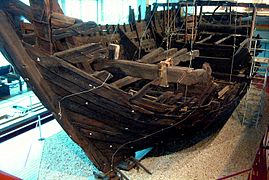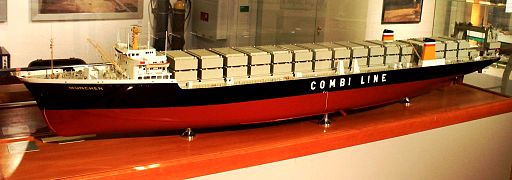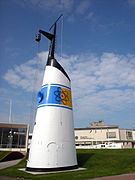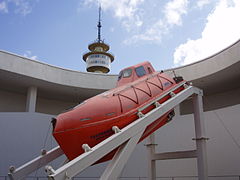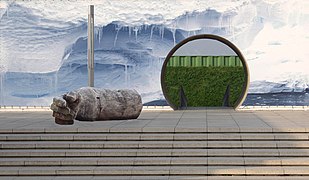German Maritime Museum
| German Maritime Museum - Leibniz Institute for Maritime History | |
|---|---|
 Museum logo |
|
| Category: | Research facility , museum |
| Carrier: | Foundation under civil law |
| Consist: | Since 1971 (foundation) / 1975 (museum) |
| Membership: | Leibniz Association |
| Facility location: | Bremerhaven |
| Type of research: | Basic research |
| Subjects: | Humanities , natural sciences |
| Areas of expertise: | History , engineering |
| Basic funding: | Federal government (50%), states (50%) |
| Management: | Sunhild Kleingärtner (Managing Director) |
| Employee: | about 80 |
| Homepage: | www.dsm.museum |
The German Maritime Museum (DSM) in Bremerhaven is the national maritime museum in Germany. As a Leibniz Institute for Maritime History, the museum belongs to the Leibniz Association . As one of eight research museums in the community, it combines exhibition and research activities. The entire complex with buildings and museum fleet has been a listed building since 2005 .
history
As early as 1935 there was the suggestion of the shipping historian Otto Höver, who had been head of the city library since 1932, to set up a shipping museum. Fritz Lücke, the director of the Institute for Sea Fisheries, thought "the idea was good and feasible and believes that the large room adjoining the fishing port museum is suitable for accommodating a shipping museum". To celebrate the 50th anniversary of German deep-sea fishing, there should be "a special exhibition of fish steamer models that could serve as the basis for a maritime museum" in 1936. Mayor Wilhelm Richter replied to the suggestion “that he could not take up the remoteness during the war, but that he hoped to be able to implement the plan later”.
From November 1969 to 1972/1975, the museum building was planned and built according to designs by the architect Hans Scharoun in collaboration with the Bremerhaven architects Helmut Bohnsack and Peter Fromlowitz. With buildings like this museum or the Berlin Philharmonic, Scharoun is one of the most important representatives of organic architecture . The total costs up to the opening amounted to 23 million DM.
Scientific research began at the DSM in 1971. In 1972, the restoration and subsequent conservation of the Bremen cog began in the now completed cog hall . On September 5th, 1975, after the exhibition was designed, the DSM was opened to the public by the then Federal President Walter Scheel by ringing a ship's bell.
The three founding directors of the museum were Detlev Ellmers (1971–2002 managing director), Gert Schlechtriem (previously director of the Morgenstern Museum ) and Wolf-Dieter Hoheisel (technical director). From 2004 to 2012 the DSM was headed by the shipping historian Lars Ulrich Scholl as managing director.
From 1976 Arnold Kludas directed and designed the scientific library of the DSM .
The collection was expanded to include additional exhibits and additions.
At the end of 2014, the Leibniz Association confirmed the museum's status as a National Research Museum for a further four years , which is linked to high public funding. Instead of the regular approval of a seven-year funding period, based on the results of the evaluation, only a shortened funding period was approved until the next evaluation.
In May 2018, the German Maritime Museum was renamed the German Maritime Museum in order to comply with the recommendations of the spelling reform with the triple consonants .
Monument protection
In 2005 the German Maritime Museum was placed under monument protection.
For my 40th birthday
In 2015 the DSM celebrated with an anniversary exhibition “1975/2015 - Ships tell museum stories”. Spread over twelve stations, nine in the Scharoun building and three stations outside the building, the museum could be experienced on its 40th birthday. The anniversary exhibition was also to be understood as an announcement, as in the coming years all exhibition areas will be gradually renewed and the building will also be completely renovated.
Especially for the future research approach of the museum under the motto “Man and Sea”, a new exhibition concept has been developed for the entire museum and the museum harbor since the beginning of 2014, with the aim of making “research as a process” visible. Topics and contexts are reformulated according to the current research focus and the objects are rearranged with the corresponding background information, stories and narratives.
Exhibits
The main attraction is the Bremen cog from 1380, which was found in Bremen since 2000. The exhibition rooms contain showpieces on various shipping eras and on the subjects of merchant shipping, fishing and whaling, polar research, the military and more. Among other things, models of sailing ships, container ships, passenger ships and oil tankers as well as technical controls and equipment are exhibited. One of the showpieces is a mechanical tide calculator used by the Deutsche Seewarte in Hamburg from 1919 to 1935 , which is classified as an early computer.
Pictures of indoor exhibits
Model of the Gustav Zeuner crawler tractor
Model of the express steamer Kaiser Wilhelm the Great
Model of the passenger steamer Cap Arcona
Model of the lash carrier Munich
Rudder propeller type SRP 100 from Schottel
Watercraft
The following watercraft can be viewed in the museum harbor:
- Bark Seute Deern (sunk at the end of August 2019, not accessible)
- Deep sea tug Seefalke
- Whaling steamer RAU IX of the Walter Rau whaling fleet
- Haffkahn Emma
- Inland tug Helmut
- Lightship Elbe 3 (formerly Mayor Abendroth , not to be confused with lightship Elbe 3 in the museum harbor Oevelgönne in Hamburg)
Four ships can be viewed in the outdoor area:
- Concrete ship Paul Kossel
- Port tug Stier with Voith Schneider drive
- Sailing yacht Diva
- Hydrofoil WSS 10
The ship of the First German North Polar Expedition , the Nordic Jagt Greenland , built by Toleff Toleffsen in Skånevik , Norway in 1867, is also part of the museum's fleet, but is an active traditional ship and therefore rarely in the museum harbor, especially in the summer months.
In the port basin of the museum there is also the accessible submarine Wilhelm Bauer , which is looked after by an independent sponsoring association.
The Jaguar-class speedboat Kranich was in the museum harbor until 2006; it was sold for scrapping by VEBEG due to the severe deterioration of the wooden hull .
In front of the museum is a sculpture by the sculptor Stephan Balkenhol .
Pictures of outdoor exhibits
Chimney of the nuclear ship Otto Hahn
Free fall lifeboat Frederike
Arm sculpture by Stephan Balkenhol in front of the museum
Publications
The German Shipping Archive , the museum's scientific yearbook , has been published annually since 1975 . The subject areas include aspects such as ship archeology, sea and inland shipping, shipbuilding, navy, fisheries, navigation, polar and marine research, social history of seafaring, maritime folklore. The focus is on shipping history, with contributions by foreign authors showing the state of international research. All contributions are supplemented with English and French summaries. It is published by Oceanum Verlag Wiefelstede (DSA 31 2008, ISBN 978-3-86927-031-9 ), ISSN 0343-3668 .
Internet projects
- German shipping in the 1920s and 1930s in the field of tension between continuities, crises and innovation Visualization of historical processes
- Ship list - an Internet database for quickly finding historical ships, boats and other watercraft, some of which are described with detailed technical characteristics and data on the curriculum vitae.
- Digitization of ship plans
Research assignment
In August 2011, the German Federal Government awarded the museum a research contract for the systematic archaeological prospecting of the North Sea, also outside the 12 nautical mile zone , as numerous archaeological sites are threatened by planned construction projects such as offshore wind farms, pipelines and power lines.
literature
- Dirk Peters : The historic barque SEUTE DEERN. 50 years in the old harbor and museum harbor in Bremerhaven . In: Men from Morgenstern , Heimatbund an Elbe and Weser estuary e. V. (Ed.): Niederdeutsches Heimatblatt . No. 797 . Nordsee-Zeitung, Bremerhaven May 2016, p. 3 ( mvm.de [PDF; 814 kB ; accessed on July 27, 2019]).
- Dirk Peters: The Bark SEUTE DEERN provided the impetus. 50 years of the Bremerhaven Shipping History Society (1966–2016) . In: Men from Morgenstern, Heimatbund an Elbe and Weser estuary e. V. (Ed.): Niederdeutsches Heimatblatt . No. 802 . Nordsee-Zeitung, Bremerhaven October 2016, p. 1–2 ( mvm.de [PDF; 10.1 MB ; accessed on July 23, 2019]).
- Hans Graulich: The story of the “Presidential Lab”. The former head chef at Seute Deern remembers . In: Men from Morgenstern, Heimatbund an Elbe and Weser estuary e. V. (Ed.): Niederdeutsches Heimatblatt . No. 824 . Nordsee-Zeitung, Bremerhaven August 2018, p. 1–2 ( mvm.de [PDF; 4.5 MB ; accessed on January 19, 2019]).
- Marleen von Bargen: “Faithful in storms!” - a flag and its story. The flag of the “Association of Stokers and Coal Pullers Bremerhaven and the Surrounding Area” in the German Maritime Museum . In: Men from Morgenstern, Heimatbund an Elbe and Weser estuary e. V. (Ed.): Niederdeutsches Heimatblatt . No. 827 . Nordsee-Zeitung, Bremerhaven November 2018, p. 1–2 ( mvm.de [PDF; 4.3 MB ; accessed on July 5, 2019]).
- Hans-Walter Keweloh: A National Maritime Museum for Bremerhaven. Fifty years ago, Bremen submitted an application to the Federal Ministry of Research . In: Men from Morgenstern, Heimatbund an Elbe and Weser estuary e. V. (Ed.): Niederdeutsches Heimatblatt . No. 829 . Nordsee-Zeitung, Bremerhaven January 2019, p. 2–3 ( mvm.de [PDF; 3.9 MB ; accessed on June 18, 2019]).
Web links
Individual evidence
- ↑ dsm.museum
- ↑ The Leibniz Research Museums. In: Leibniz Association website. Retrieved August 9, 2019 .
- ↑ Exhibits in the exhibition. In: German Maritime Museum website. Retrieved August 9, 2019 .
- ^ Burchard Scheper: The more recent history of the city of Bremerhaven. Bremerhaven 1977, ISBN 3-921749-00-X , p. 297.
- ↑ a b c Note in: The year 1975 in the picture. Carlsen Hamburg 1975, p. 88.
- ↑ “There are various crystallization nuclei that led to the establishment of the German Maritime Museum in Bremerhaven. The war had destroyed the Museum of Oceanography in Berlin. A central point for the research and presentation of shipping was missing; … On February 5, 1961, the Morgenstern Museum … was opened. … In a speech, the head of the cultural department, City Councilor Alfons Tallert , particularly advocated the expansion and promotion of [the] shipping department. With skill, tenacity and instinct, the director of the Morgenstern Museum , Gert Schlechtriem , expanded the shipping department, which gradually became a focus of the museum's work, so that in 1965 new rooms had to be added. ... In 1966 the Maritime History Society was founded to support these efforts. The Cologne lawyer Dr. Hanswilly Bernartz , whose large private collection became a starting point for the establishment of the German Maritime Museum. ”(Burchard Scheper: The recent history of the city of Bremerhaven. Bremerhaven 1977, ISBN 3-921749-00-X , p. 461.)
- ↑ a b About construction sites, beer pots and Hansekoggen: 40 years of DSM on the Bremerhaven website recalls Prof. Dr. Detlev Ellmers on the founding time. ( Memento from March 5, 2016 in the Internet Archive ) In: Website City of Bremerhaven. Retrieved August 9, 2019.
- ^ Library in the German Maritime Museum. In: Website of the Lower Saxony State and University Library Göttingen . Retrieved August 9, 2019 .
- ^ Klaus-Peter Kiedel, Lars U. Scholl : Head of the library of the German Shipping Museum 1976–1992, on his 80th birthday on October 18, 2009. In: German Shipping Archive. 31 (2008), pp. 9-15.
- ↑ Research status on probation. ( Memento from February 15, 2015 in the Internet Archive ) Radio Bremen website; accessed on August 9, 2019.
- ↑ German Maritime Museum positively evaluated. In: Website Senate Press Office Bremen. Retrieved May 26, 2016 .
- ↑ The Maritime Museum becomes the Maritime Museum. In: Weser-Kurier website . May 20, 2018. Retrieved May 27, 2018 .
- ↑ 40 years of the German Maritime Museum. ( Memento from March 5, 2016 in the Internet Archive ) In: German Maritime Museum website. Retrieved August 9, 2019.
- ↑ Our research projects. In: German Maritime Museum website. Retrieved August 9, 2019 .
- ↑ List of ships. In: German Maritime Museum website. Retrieved August 9, 2019 .
- ^ Search for sunken cultures in the North Sea. ( Memento from May 12, 2012 in the Internet Archive ) In: Radio Bremen website . Retrieved August 9, 2019.
Coordinates: 53 ° 32 ′ 24.2 " N , 8 ° 34 ′ 37.2" E

